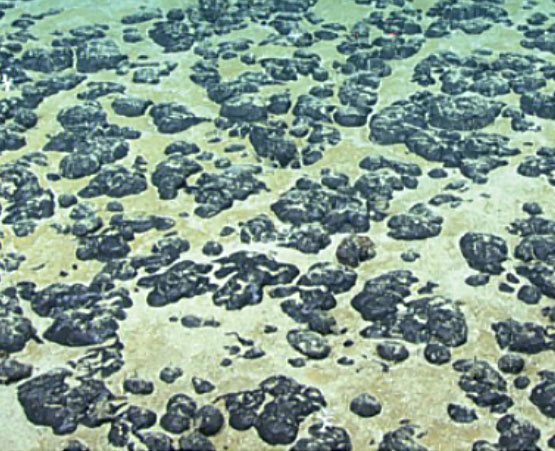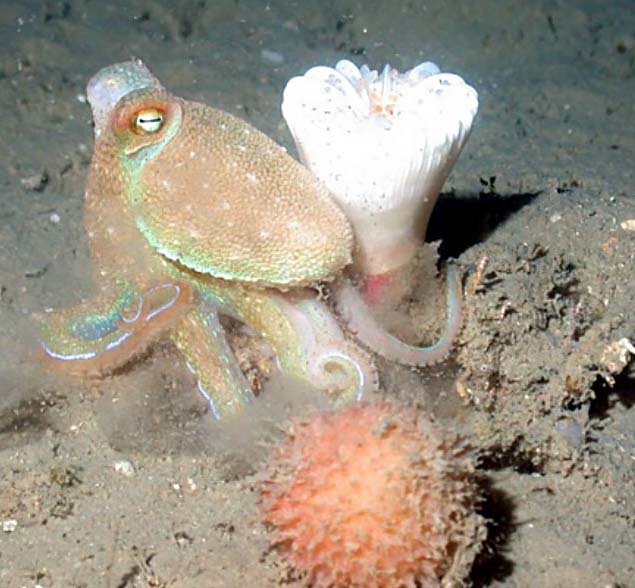Deep sea mining imperils ‘our greatest ally’, the Ocean
By Philip Pearson
Mining companies are negotiating controversial permits from the UN’s International Seabed Authority (ISA) to strip mine metallic nodules on the deep Ocean floor for the copper, cobalt and nickel they contain.
Marine scientists, governments and environmental bodies believe that deep seabed mining will worsen the climate crisis, by destroying the natural carbon storage capacity of the deep Ocean, and disrupt marine cycles that add to these carbon stores.
A new report, Undisturbed: the deep Ocean’s role in safeguarding us from the climate crisis, calls on governments and civil society organizations, both at COP27 and at the ISA negotiations in Jamaica (November 2022), to stop the miners in their tracks.

Image: Seabed nodules, Challenger Expedition, 1873

Image: Seabed nodules, Flora and Fauna International
In her book, The brilliant abyss marine scientist Helen Scales argues that ‘the ISA is tragically failing in its responsibilities to safeguard life in the abyss, not to mention threatening the rest of the planet.’
Yet the UK government, sponsor of commercial deep sea mining, has repeatedly resisted calls to halt its development.
So, why the extractivist drive to strip mine the Ocean floor? And what is at stake?
Our common heritage
Across the plains of the deep Ocean, at depths of 4000-5000 meters, metal-bearing nodules, rich in cobalt, manganese, copper and nickel lie close together much like potatoes on a field.
The knuckle-shaped nodules form slowly over millions of years by the precipitation of metal ions in seawater around objects on the sea floor, like a shark’s tooth or clam shell – just like a pearl forms around a grain of sand. A nodule on display at the Natural History Museum, London developed around the tooth of a long-dead Megalodon, a giant shark extinct for three million years.

Image: Cross-section of nodule showing accumulating metal rings: Flora and Fauna International
Ironically, the expanding green economy is boosting demand for these metals, for batteries, electric cars, parts for solar panels, wind turbines, as well as mobile phones and other new technologies: over six million electric vehicles were sold last year, and sales may triple by 2025.
‘What’s yours is mine’
Marine biologist Helen Scales argues that,
‘The proposed mining ventures bear the hallmarks of extractivism, a centuries-old economic model commonly associated with colonialism and latterly with transnational corporations that extract natural raw materials for export. The goal is to mine a resource on a one-shot basis, then move on elsewhere and repeat.’

Image: NOAA, Nautilus Expedition. Octopuses lay their eggs in sponges anchored to metallic nodules: Flora and Fauna International
The Metals Company, one of the main companies pushing deep sea mining, has been testing mining equipment in the depths of the Pacific Ocean since mid-September. According to its CEO, Gerrard Barron, ‘The nodules are literally sitting there like golf balls on a driving range…[during mining] micro-organisms on the seabed are not destroyed. Instead, they are shaken up and carry on.’ His company has negotiated numerous exploration pilot licences in extractive partnerships with the Pacific island states of Nauru, Tonga and Kiribati.
The UK government sponsors two deep sea mineral exploration contracts in the Pacific, via UK Seabed Resources, a wholly-owned subsidiary of the weapons company Lockheed Martin. UKSR claims, ‘Seabed harvesting is an ecologically sound method for meeting the growing global demand for precious metals.’
The Ocean: our buffer against climate change
However, a joint study by the Scripps Institution of Oceanography, and the International Programme on the State of the Ocean highlights the vital role the deep Ocean plays in the functioning of our planet, including ‘buffering’ the impacts climate change. Their report, Undisturbed says:
‘The bonds between The Ocean and climate change run deep. The deep Ocean helps to regulate Earth’s climate by absorbing and storing over 90% of the excess heat and approximately 38% of the carbon dioxide generated by humanity.’ A new extractive deep-sea industry would lead to biodiversity loss and disruption of ecosystem services on an enormous scale. ‘Widespread destruction of the seafloor would bring long-term impacts on carbon cycling and storage in the deep.’
Strip mining the seabed will add significantly to the multiple threats already facing the deep Ocean, including rising temperatures and acidity, species extinction, glacier melt, micro-plastic pollution and over fishing.
How deep sea mining works

Image: EU mining impact studies
Mining pilot videos depict massive 16-meter wide bulldozers lowered from a mother ship to 4000-5000 meters. They scoop up the top 15 cm of sea floor sediments, nodules and all marine life in their path. The nodules are separated from the ‘slurry,’ which is blasted out the back of the machine in a continuous plume. The nodules are sucked up a riser pipe to the ship. Waste material is dumped back in the sea. Flora and fauna accustomed to a dark, near-silent environment face a 24/7 regime of machine noise, with floodlights for remote monitoring.
Over a two-week period, an estimated 100,000 tonnes of material could be removed. A 30-year operating licence would strip 10,000 square kilometres of the seabed.
Deep sea mining: environmental impacts
Deep sea mining impact studies sponsored by the EU concluded that ‘metal nodule ecosystems support a unique and highly diverse fauna of static and mobile species.’ Impacts of ‘even small-scale experimental seafloor disturbances on nodule habitats last for many decades and affected numerous ecosystems.’
For Prof. Philip Weaver of the National Oceanography Centre, ‘The highest priority is to determine the response of organisms to the impacts of plumes, including their particle load and toxicity.’ Toxic-laden particles in the slurry blasted out of the back of the bulldozers can smother, choke, harm or kill animal and plant life and pollute pristine marine environments over tens or hundreds of kilometres around the strip mine.
Anemones, sponges, corals, nematode worms and microscopic tardigrades (aka ‘water bears’) attach themselves to the nodules, and are more abundant than in areas without nodule coverage.

Image: Tardigrade (1.2mm):
American Museum of natural History
| Issue | Environmental and climate change impacts |
| Carbon absorption and storage | Widescale disturbance of carbon sinks (marine sediments storing carbon emissions). Significant effects on marine species’ carbon cycling and storage processes. |
| Loss of species, removal of rocks and other matter hosting organisms |
Removal and destruction of seafloor habitats along with their unique fauna. Biodiversity loss, ecosystem disruption, migration barriers for many species. Loss of many as yet unknown species. Deposits from widely dispersed vehicle ‘slurry’ takes tens to hundreds of years to settle and consolidate. |
| Impacts of exhaust plumes | Exhaust plumes spread many kilometres beyond mined area, impacting vulnerable species on the seabed or in the water. |
| Waste matter | Waste material discarded overboard impacts on free-floating organisms. |
| Fauna recovery time | Many decades to hundreds of years for the recovery of surviving deep sea fauna, including corals and sponges. |
Time to ‘Stop’ mining in its tracks
The United Nations is responsible for the regulation and stewardship of international waters through UN Convention on the Law of the Sea (1982) ‘on behalf of all humankind.’ Article 136 defines the deep ocean and its resources as ‘the common heritage of mankind.’ The UN delegated the development of rules and regulations for the effective protection of the marine environment to the International Seabed Authority (ISA). https://www.isa.org.jm/
Controversially, the ISA is currently (November 2022) drafting regulations covering
‘exploration and exploitation’ of mineral resources on the Ocean floor. It handed this task to an obscure, 30-member Legal and Technical Commission, often meeting behind closed doors. The ISA’s incumbent General Secretary in 2022, Michael Lodge, has shown ample signs of his pro-mining stance.
Under a two-year rule triggered in July 2021 by the Pacific island nation of Nauru, exploitation of the seabed could commence by July 2023 even if environmental or economic regulations have not been agreed. Greenpeace estimates that ‘contracts to explore for deep sea mining potential covering over a million square kilometres of the international seabed have been given out by the ISA.’
The Metals Company’s sponsorship deals with Pacific island nations Nauru, Tonga and Kiribati has secured exploration rights to 150,000 square kilometers of seabed. The company’s $2.9 billion value vastly exceeds the combined GDPs of its three ‘partners.’ In Nauru’s case, much of the small Pacific island has been devastated by phosphate mining. Its riches squandered, the island contracted to host Australia’s ‘offshore’ refugee detention centre. Seabed mining is the latest idea for digging the country out of financial trouble.
In Jamaica, the Deep Sea Conservation Coalition of NGOs, youth groups, political leaders, MPs, technology and car companies, and scientists has urged the Authority to ‘stop to the destructive industry before it starts.’ Some ISA member states, including Germany, Spain and New Zealand, are calling for a ‘pause and reflection’ over the whole deep sea mining process.
Recycling?
‘The whole global mindset on recycling of metals has to change,’ says the UN’s Environment Programme (UNEP). Mobile phones contain more than 40 metal elements, including copper, tin and cobalt, but recycling rates are minimal. UNEP is calling for ‘Policy and legislation to mandate product recycling standards and incentives.’ In the UK, with the exception of steel, metals recycling rates are low across the board. The UK’s critical minerals strategy offers no new legislation to improve recycling and recovery. Yet it sponsors deep sea mining.
Greenpeace says:
Governments have been far too passive in holding the ISA to account. While they are negotiating at COP 27 to combat the climate crisis, an obscure international regulator is undermining their efforts by advancing deep sea mining. During this round of negotiations delegates must reaffirm the commitments they have made to protecting the ocean and truly preserve it as the common heritage of humankind.
How to find out more: https://www.greenpeace.
Sources
Helen Scales, The brilliant abyss, (2021)
https://www.youtube.com/watch?v=1LKfvxKpFJY
Chapter 10 exposes the ISA’s controversial drive to facilitate deep sea mining.
Greenpeace: Deep Trouble – The murky world of the deep sea mining industry: https://tinyurl.com/2zhet822
Undisturbed: the deep Ocean’s vital role in safeguarding us from crises:
State of negotiations: https://tinyurl.com/2bxnj33a
Philip Weaver and others, Assessing plume impacts caused by nodule mining vehicles
https://www.sciencedirect.com/science/article/pii/S0308597X22000586
Flora and fauna International: https://tinyurl.com/4akfhxtu
EU Joint Programme Initiative, Ecological Aspects of Deep-Sea Mining:
https://www.jpi-oceans.eu/en/about
The Metals Company:
https://www.axios.com/2021/07/06/undersea-mining-lithium-electric-vehicles
Philip Pearson, GJA joint coordinator, uncovers the vested interests at stake and why environmental campaigns, marine scientists and governments demand a halt to deep sea mining.
First published here: www.a-challengers-song.co.uk
